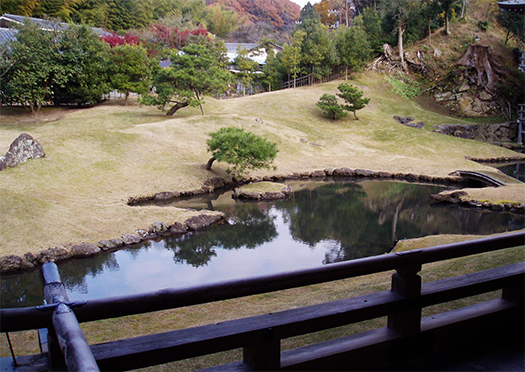


建長寺は本格的禅宗寺院としては日本で最初期のもの。
鎌倉幕府を挙げての宗教建築文化として、宋の最新宗教文化の移植だった。
その特徴として「作庭」という分野に注目したことがあるのでしょう。
法隆寺にはそういう傾向はないし、高野山でも特記するようでもない。
仏教の発展の結果、こういった建築の分野が大きく成長したものでしょう。
この建長寺の方丈、住持の居住棟に付属して庭園が広がっている。
禅宗文化はまず鎌倉で展開し、その後政治中心が室町幕府とふたたび京都に
回帰していくなかでたくさんの禅寺が京都で建築されて
今日に至る京都文化の中核に位置するようになる。
この建長寺庭園もその後の室町期に活躍した夢窓疎石作庭とながく流布された。
しかし、実際には建長寺開基の蘭渓道隆による作庭だという。
ということは、禅宗文化には建築にともなって重要な建築要素として
庭園文化というものがメインファクターを成していたということ。
蘭渓道隆作庭ということだとしても、夢窓疎石ものちに鎌倉で遊学しているので、
まったく関与していないのかどうかもわからない。
禅宗としての宗教運動の流れの中で、さまざまな交流があったことは自然。
いわば禅宗庭園文化というものが揺籃されてきた、と見るべきかも知れない。
蘭渓道隆は宋からの来日僧だけれど、夢窓疎石は天皇家とも繋がる日本生まれ。
いわば日本人好みに禅宗文化が変容していくなかで名が上がったのではないか。
輸入された建築文化に対してさまざまな日本的感受性が付与されていって
いかにも日本的空間美を反映していった過程がこうしたものだった。
夢窓疎石は7代の天皇が師事したとされるので、
日本の禅宗文化に決定的な刻印を施したといえるのでしょう。
かれが建築し、作庭したという寺院は日本中に多数存在している。
今日に至る日本人の審美眼的DNAに対して非常に大きな関与をしている。
そう考えれば、こういう庭園文化というものの奥行きが知れる。
言ってみれば中国からのアジア文化を受け入れてアレンジさせたものが
ひとつの典型的日本美を形成し、文化としてはその次に日本は
欧米世界と出会って大きな変容を遂げて行くというのが大きな「つかみ」か。
いずれにしても、このような禅宗的な自然との対話、
そしてその審美の尺度も禅宗的な価値感で作られていったということか。
わたしは北海道人なので、こういった自然観ともまた違った
拡張された「花鳥風月」を強く感じる自然環境に抱かれているのですが、
一方でこうした「わびさび」世界にもまた惹かれる。
ちょうど「和の住まい推進リレーシンポジウム in 北海道」という案内が来て
「瓦、縁側、深い軒」という日本建築美云々というテーマが示されている。
https://us06web.zoom.us/webinar/register/WN_SfbP7IM1SHChrqwkGWV9Yw
ほぼ北海道住宅建築には存在しない(笑)建築文化・・・。
こういうのを「国土交通省、経済産業省、林野庁」が推進するという。
なかなかにリアルタイムなデザイン論であるかも知れません。興味深い。
English version⬇
[Zen Buddhist Garden as Architectural Culture Kenchoji Temple-9]
Kenchoji is the earliest full-scale Zen Buddhist temple in Japan.
It was a transplant of Song’s latest religious culture as a religious architectural culture of the Kamakura Shogunate.
Perhaps you have paid attention to the field of “garden making” as its characteristic.
There is no such tendency in Horyuji Temple, and neither Mt. Koya nor anything special is mentioned.
As a result of the development of Buddhism, this field of architecture will have grown significantly.
The garden is attached to the residence building of the priest, Kenchoji Temple.
Zen Buddhism first developed in Kamakura, then the center of politics returned to the Muromachi Shogunate in Kyoto.
Many Zen temples were built in Kyoto as we returned
It will be located at the core of Kyoto culture to this day.
This Kenchoji garden has also been disseminated as the Muso Soseki garden that was active during the Muromachi period.
However, it is said that the garden was actually created by Lanxi Daolong, the founder of Kenchoji Temple.
This means that it is an important architectural element in Zen Buddhism culture along with architecture.
The garden culture was the main factor.
Even if it’s a Lanxi Daolong garden, I’m studying in Kamakura at Muso Soseki.
I don’t know if I’m not involved at all.
It is natural that there were various exchanges in the flow of religious movements as Zen Buddhism.
So to speak, it should be seen that the Zen sect garden culture has been shaken.
Lanxi Daolong is a monk from Song, but Muso Soseki was born in Japan, which is also connected to the Emperor.
So to speak, it seems that the name has risen as the Zen Buddhism culture has transformed into Japanese tastes.
Various Japanese sensitivities have been given to the imported architectural culture.
This was the process that reflected the beauty of Japanese space.
Muso Soseki is said to have been studied by the 7th emperor.
It can be said that the definitive stamp was given to the Zen Buddhism culture in Japan.
There are many temples in Japan that he built and built.
It has a great deal of involvement in the aesthetic DNA of the Japanese people to this day.
If you think so, you can see the depth of this kind of garden culture.
So to speak, the one that accepted and arranged Asian culture from China
Forming one typical Japanese beauty, Japan is next in terms of culture
Is it a big “grab” to meet the Western world and make a big transformation?
In any case, such a dialogue with Zen Buddhism nature,
And the scale of aesthetics was also made with a sense of Zen Buddhism.
I’m from Hokkaido, so it’s different from this view of nature.
I am embraced by the natural environment that makes me feel the expanded “Kacho Fugetsu” strongly.
On the other hand, I am also attracted to this “Wabi-sabi” world.
The information “Japanese House Promotion Relay Symposium in Hokkaido” has just arrived.
The theme of Japanese architectural beauty, “tiles, porch, deep eaves,” is shown.
https://us06web.zoom.us/webinar/register/WN_SfbP7IM1SHChrqwkGWV9Yw
Almost does not exist in Hokkaido residential architecture (laughs) Architectural culture …
It is said that “Ministry of Land, Infrastructure, Transport and Tourism, Ministry of Economy, Trade and Industry, Forestry Agency” will promote this.
It may be quite a real-time design theory. Interesting.
Posted on 12月 24th, 2021 by 三木 奎吾
Filed under: 住宅マーケティング, 日本社会・文化研究







コメントを投稿
「※誹謗中傷や、悪意のある書き込み、営利目的などのコメントを防ぐために、投稿された全てのコメントは一時的に保留されますのでご了承ください。」
You must be logged in to post a comment.